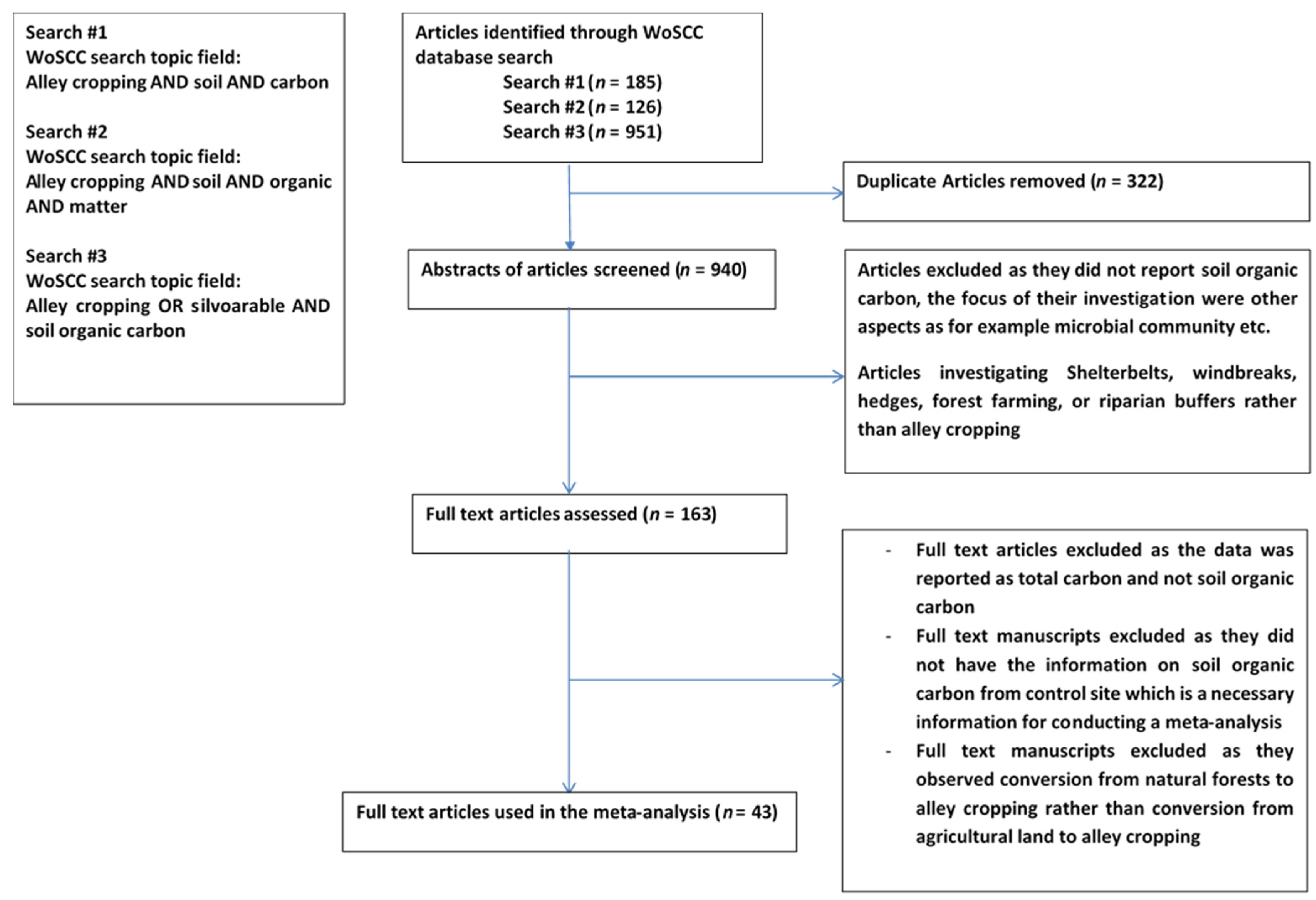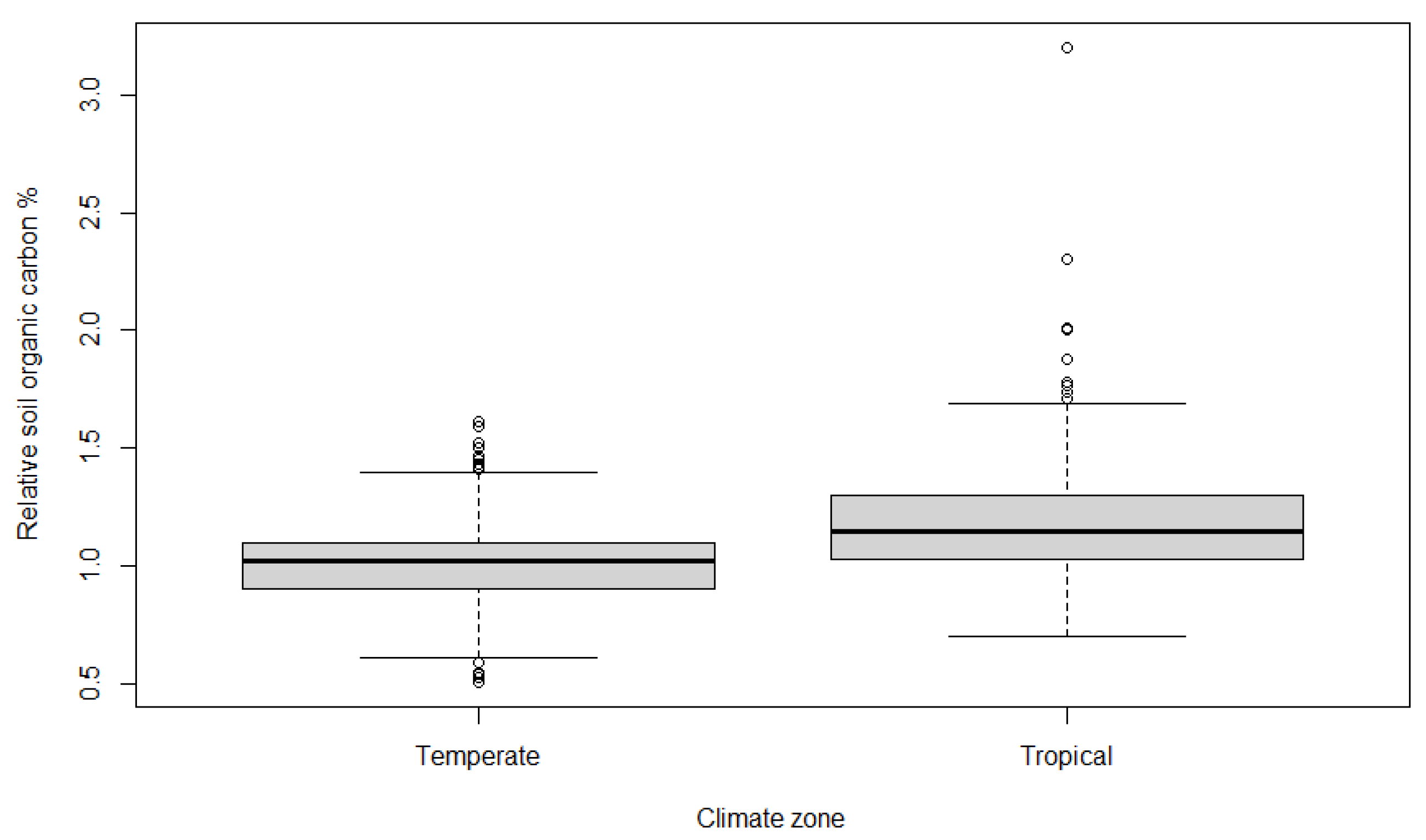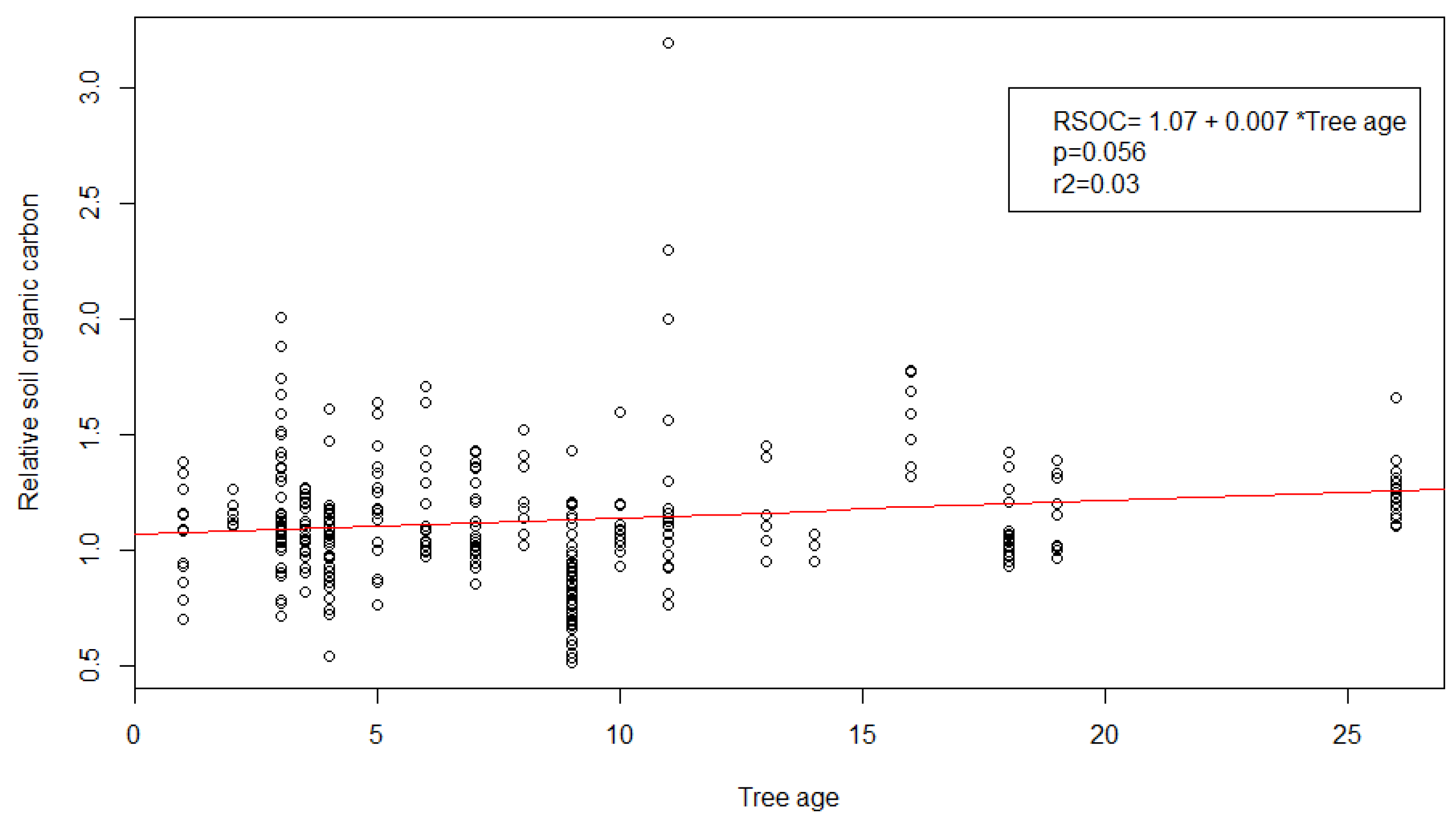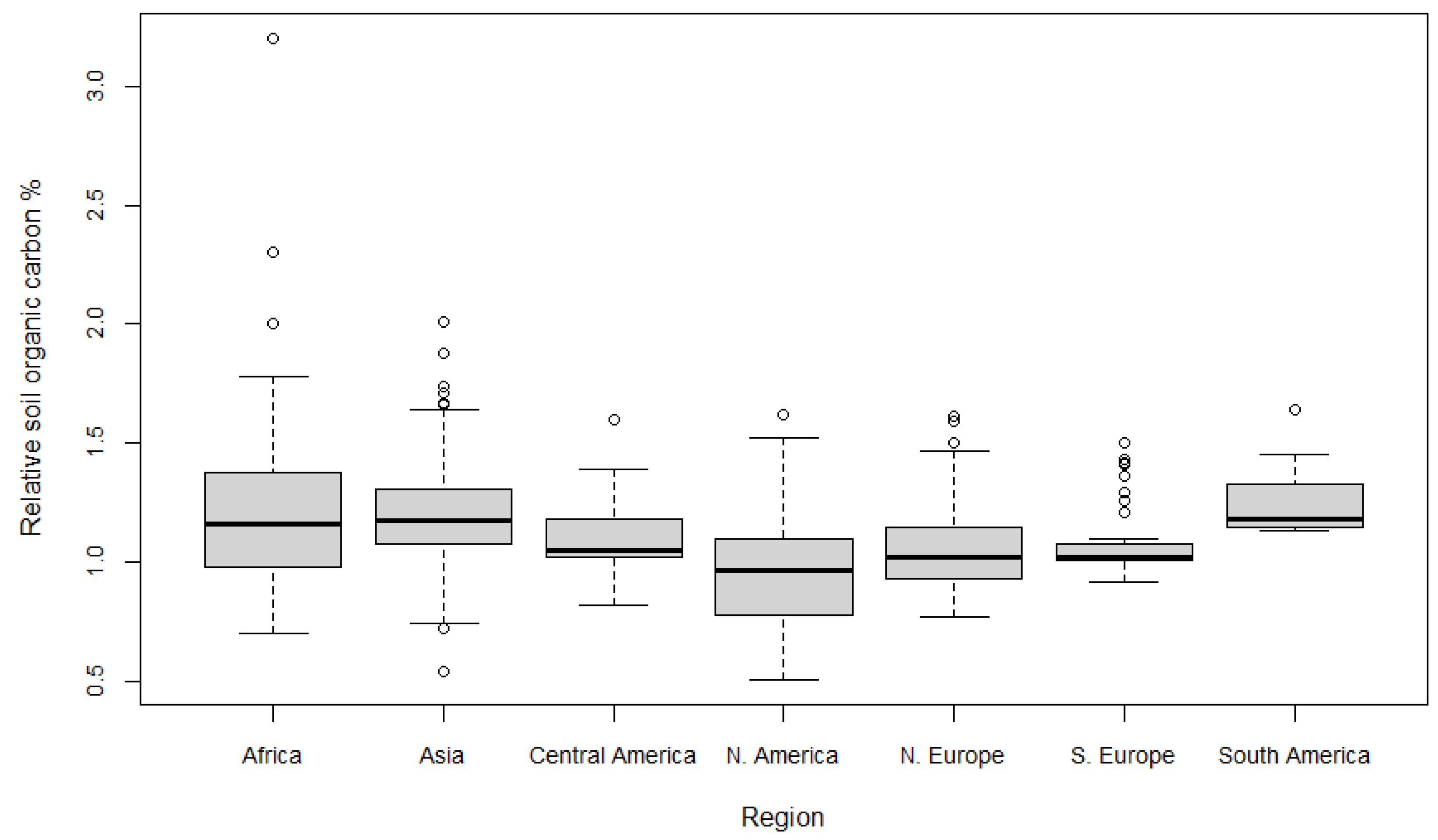Soil Organic Carbon in Alley Cropping Systems: A Meta-Analysis
Abstract
:1. Introduction
2. Materials and Methods
2.1. Data Collection
2.2. Standardization and Calculation of the Carbon Data
2.3. Statistical Analysis
3. Results and Discussion
3.1. Soil Organic Carbon in Alley Cropping Systems in Different Regions and Climate Zones
3.2. Effect of Tree Age on Soil Organic Carbon in an Alley Cropping System
4. Conclusions
Author Contributions
Funding
Institutional Review Board Statement
Informed Consent Statement
Data Availability Statement
Acknowledgments
Conflicts of Interest
References
- Yan, Y.; Zhou, X.; Jiang, L.; Luo, Y. Effects of carbon turnover time on terrestrial ecosystem carbon storage. Biogeosciences 2017, 14, 5441–5454. [Google Scholar] [CrossRef] [Green Version]
- Lal, R. Carbon sequestration. Phil. Trans. R. Soc. B 2008, 363, 815–830. [Google Scholar] [CrossRef]
- Six, J.; Callewaert, P.; Lenders, S.; De Gryze, S.; Morris, S.J.; Gregorich, E.G.; Paul, E.A.; Paustianet, K. Measuring and understanding carbon storage in afforested soils by physical fractionation. Soil Sci. Soc. Am. J. 2002, 66, 1981–1987. [Google Scholar] [CrossRef] [Green Version]
- Stavi, I.; Lal, R. Agroforestry and biochar to offset climate change: A review. Agron. Sustain. Dev. 2013, 33, 81–96. [Google Scholar] [CrossRef] [Green Version]
- Verchot, L.V.; Noordwijk, M.; Kandji, S.; Tomich, T.; Ong, C.; Albrecht, A.; Mackensen, J.; Bantilan, C.; Anupama, K.V.; Palm, C. Climate change: Linking adaptation and mitigation through agroforestry. Mitig. Adapt. Strateg. Glob. Chang. 2007, 12, 901–918. [Google Scholar] [CrossRef] [Green Version]
- Cardinael, R.; Chevallier, T.; Cambou, A.; Béral, C.; Barthès, B.G.; Dupraz, C.; Durand, C.; Kouakoua, E.; Chenu, C. Increased soil organic carbon stocks under agroforestry: A survey of six different sites in France. Agric. Ecosyst. Environ. 2017, 236, 243–255. [Google Scholar] [CrossRef] [Green Version]
- Pandey, D.N. Carbon sequestration in agroforestry systems. Clim. Policy 2002, 2, 367–377. [Google Scholar] [CrossRef]
- Peichl, M.; Thevathasan, N.V.; Gordon, A.M.; Huss, J.; Abohassan, R.A. Carbon sequestration potentials in temperate tree-based intercropping systems, southern Ontario, Canada. Agrofor. Syst. 2006, 66, 243–257. [Google Scholar] [CrossRef]
- Weerasekara, C.; Udawatta, R.P.; Jose, S.; Kremer, R.J.; Weerasekara, C. Soil quality differences in a row-crop watershed with agroforestry and grass buffers. Agrofor. Syst. 2016, 90, 829–838. [Google Scholar] [CrossRef]
- Bergeron, M.; Lacombe, S.; Bradley, R.L.; Whalen, J.; Cogliastro, A.; Jutras, M.-F.; Arp, P. Reduced soil nutrient leaching following the establishment of tree-based intercropping systems in eastern Canada. Agrofor. Syst. 2011, 83, 321–330. [Google Scholar] [CrossRef]
- Tully, K.L.; Lawrence, D.; Scanlon, T.M. More trees less loss: Nitrogen leaching losses decrease with increasing biomass in coffee agroforests. Agric. Ecosyst. Environ. 2012, 161, 137–144. [Google Scholar] [CrossRef]
- Beuschel, R.; Piepho, H.-P.; Joergensen, R.G.; Wachendorf, C. Impact of willow-based grassland alley cropping in relation to its plant species diversity on soil ecology of former arable land. Appl. Soil Ecol. 2020, 147, 103373. [Google Scholar] [CrossRef]
- Lal, R. Deforestation and land-use effects on soil degradation and rehabilitation in western Nigeria. III. Runoff, soil erosion and nutrient loss. Land Degrad. Dev. 1996, 7, 99–119. [Google Scholar] [CrossRef]
- Torralba, M.; Fagerholm, N.; Burgess, P.J.; Moreno, G.; Plieninger, T. Do European agroforestry systems enhance biodiversity and ecosystem services? A meta-analysis. Agric. Ecosyst. Environ. 2016, 230, 150–161. [Google Scholar] [CrossRef] [Green Version]
- Young, A. Agroforestry for Soil Management, 2nd ed.; CAB International: Wallingford, UK, 1997. [Google Scholar]
- Kass, D.L.C.; Araya, J.S.; Sanchez, J.O.; Soto-Pinto, L.; Ferreia, P. Ten Years Experience with Alley Farming in Central America. In Proceedings of the International Alley Farming Conference (IITA), Ibadan, Nigeria, 14–18 September 1992; pp. 393–402. [Google Scholar]
- Nair, P.K.R.; Nair, V.D.; Kumar, B.M.; Showalter, J.M. Carbon sequestration in agroforestry systems. Adv. Agron. 2010, 108, 237–307. [Google Scholar]
- Lorenz, K.; Lal, R. The depth distribution of soil organic carbon in relation to land use and management and the potential of carbon sequestration in subsoil horizons. Adv. Agron. 2005, 88, 35–66. [Google Scholar] [CrossRef]
- Haynes, R.J. Labile organic matter fractions as central components of the quality of agricultural soils: An overview. Adv. Agron. 2005, 85, 221–268. [Google Scholar]
- Shi, L.; Feng, W.; Xu, J.; Kuzyakov, Y. Agroforestry systems: Meta-analysis of soil carbon stocks, sequestration processes, and future potentials. Land Degrad. Dev. 2017, 29, 3886–3897. [Google Scholar] [CrossRef]
- Dhillon, G.S.; Van Rees, K.C.J. Distribution of soil organic carbon in the light and heavy fractions for six shelterbelt species and their adjacent agricultural fields in Saskatchewan. Can. J. Soil Sci. 2017, 97, 732–744. [Google Scholar] [CrossRef]
- Laganière, J.; Angers, D.; Paré, D. Carbon accumulation in agricultural soils after afforestation: A meta-analysis. Glob. Chang. Biol. 2010, 16, 439–453. [Google Scholar] [CrossRef]
- Makowski, D.; Piraux, F.; Brun, F. From Experimental Network to Meta-Analysis; Springer: Dordrecht, The Netherlands, 2019. [Google Scholar]
- Ramesh, T.; Manjaiah, K.M.; Mohopatra, K.P.; Rajasekar, K.; Ngachan, S.V. Assessment of soil organic carbon stocks and fractions under different agroforestry systems in subtropical hill agroecosystems of north-east India. Agrofor. Syst. 2015, 89, 677–690. [Google Scholar] [CrossRef]
- Cardinael, R.; Hoeffner, K.; Chenu, C.; Chevallier, T.; Camille, B.; Dewisme, A.; Cluzeau, D. Spatial variation of earthworm communities and soil organic carbon in temperate agroforestry. Biol. Fertil. Soils 2019, 55, 171–183. [Google Scholar] [CrossRef] [Green Version]
- Lee, K.H.; Jose, S. Soil respiration and microbial biomass in a pecan—Cotton alley cropping system in Southern USA. Agrofor. Syst. 2003, 58, 45–54. [Google Scholar] [CrossRef]
- Zuur, A.; Ieno, E.; Walker, N.; Saveliev, A.; Smith, G. Mixed Effects Models and Extensions in Ecology with R; Springer: New York, NY, USA, 2009. [Google Scholar]
- R Core Team. R: A Language and Environment for Statistical Computing; R Foundation for Statistical Computing: Vienna, Austria, 2013; Available online: http://www.R-project.org/ (accessed on 10 August 2021).
- Pinheiro, J.; Bates, D.; DebRoy, S.; Sarkar, D.; R Core Team. nlme: Linear and Nonlinear Mixed Effects Models. 2020. Available online: https://CRAN.R-project.org/package=nlme (accessed on 10 August 2021).
- Islam, M.; Dey, A.; Rahman, M. Effect of tree diversity on soil organic carbon content in the homegarden agroforestry system of north-eastern Bangladesh. Small-Scale For. 2015, 14, 91–101. [Google Scholar] [CrossRef]
- Binkley, D.; Fisher, R.F. Tree Species Influences. In Ecology and Management of Forest Soils, 5th ed.; Binkley, D., Fisher, R.F., Eds.; John Wiley & Sons Ltd.: Hoboken, NJ, USA, 2020. [Google Scholar]
- Angst, G.; Mueller, K.E.; Eissenstat, D.M.; Trumbore, S.T.; Freeman, K.H.; Hobbie, S.E.; Chorover, J.; Oleksyn, J.; Reich, P.B.; Mueller, C.W. Soil organic carbon stability in forests: Distinct effects of tree species identity and traits. Glob. Change Biol. 2019, 25, 1529–1546. [Google Scholar] [CrossRef]
- Oelbermann, M.; Paul Voroney, R.; Gordon, A.M. Carbon sequestration in tropical and temperate agroforestry systems: A review with examples from Costa Rica and southern Canada. Agric. Ecosyst. Environ. 2004, 104, 359–377, ISSN 0167-8809. [Google Scholar] [CrossRef]
- Makumba, W.; Janssen, B.; Oenema, O.; Akinnifesi, F.K.; Mweta, D.; Kwesiga, F. The long-term effects of a gliricidia–maize intercropping system in Southern Malawi, on gliricidia and maize yields, and soil properties. Agric. Ecosyst. Environ. 2006, 116, 85–92. [Google Scholar] [CrossRef]
- Chatterjee, N.; Nair, P.K.R.; Chakraborty, S.; Nair, V.D. Changes in soil carbon stocks across the Forest-Agroforest-Agriculture/Pasture continuum in various agroecological regions: A meta-analysis. Agric. Ecosyst. Environ. 2018, 266, 55–67. [Google Scholar] [CrossRef]
- Nair, P.K.R. Carbon sequestration studies in agroforestry systems: A reality-check. Agrofor. Syst. 2012, 86, 243–253. [Google Scholar] [CrossRef]
- Andrianarisoa, K.S.; Dufour, L.; Bienaimé, S.; Zeller, B.; Dupraz, C. The introduction of hybrid walnut trees (Juglans nigra × regia cv. NG23) into cropland reduces soil mineral N content in autumn in southern France. Agrofor. Syst. 2016, 90, 193–205. [Google Scholar] [CrossRef]
- Oelbermann, M.; Voroney, R.P.; Thevathasan, N.V.; Gordon, A.M.; Kass, D.C.L.; Schlönvoigt, A.M. Soil carbon dynamics and residue stabilization in a Costa Rican and southern Canadian alley cropping system. Agrofor. Syst. 2006, 68, 27–36. [Google Scholar] [CrossRef]
- Gupta, N.; Kukal, S.S.; Bawa, S.S.; Dhaliwal, G.S. Soil organic carbon and aggregation under poplar based agroforestry system in relation to tree age and soil type. Agrofor. Syst. 2009, 76, 27–35. [Google Scholar] [CrossRef]
- Upson, M.A.; Burgess, P.J. Soil organic carbon and root distribution in a temperate arable agroforestry system. Plant Soil 2013, 373, 43–58. [Google Scholar] [CrossRef] [Green Version]
- Henriksen, I.; Michelsen, A.; Schlönvoigt, A. Tree species selection and soil tillage in alley cropping systems with Phaseolus vulgaris L. in a humid premontane climate: Biomass production, nutrient cycling and crop responses. Plant Soil 2002, 240, 145–159. [Google Scholar] [CrossRef]
- Rivest, D.; Lorente, M.; Olivier, A.; Messier, C. Soil biochemical properties and microbial resilience in agroforestry systems: Effects on wheat growth under controlled drought and flooding conditions. Sci. Total Environ. 2013, 463–464, 51–60. [Google Scholar] [CrossRef]
- Mao, R.; Zeng, D.-H.; Li, L.-J.; Hu, Y.-L. Changes in labile soil organic matter fractions following land use change from monocropping to poplar-based agroforestry systems in a semiarid region of Northeast China. Env. Monit. Assess. 2012, 184, 6845–6853. [Google Scholar] [CrossRef]
- Udawatta, R.P.; Rankoth, L.M.; Jose, S. Agroforestry and Biodiversity. Sustainability 2019, 11, 2879. [Google Scholar] [CrossRef] [Green Version]
- Wise, R.; Cacho, O. A bioeconomic analysis of carbon sequestration in farm forestry: A simulation study of Gliricidia sepium. Agrofor. Syst. 2005, 64, 237–250. [Google Scholar] [CrossRef]
- Cardinael, R.; Chevallier, T.; Barthès, B.; Saby, N.; Parent, T.; Dupraz, C.; Bernoux, M.; Chenu, C. Impact of alley cropping agroforestry on stocks, forms and spatial distribution of soil organic carbon: A case study in a Mediterranean context. Geoderma 2015, 259–260, 288–299. [Google Scholar] [CrossRef] [Green Version]
- Tsonkova, P.; Böhm, C.; Quinkenstein, A.; Freese, D. Ecological benefits provided by alley cropping systems for production of woody biomass in the temperate region: A review. Agrofor. Syst. 2012, 85, 133–152. [Google Scholar] [CrossRef]
- Lal, R. Deforestation and land-use effects on soil degradation and rehabilitation in western Nigeria. I. Soil physical and hydrological properties. Land Degrad. Dev. 1996, 7, 19–45. [Google Scholar] [CrossRef]
- Lal, R. Deforestation and land-use effects on soil degradation and rehabilitation in western Nigeria. II. Soil chemical properties. Land Degrad. Dev. 1996, 7, 87–98. [Google Scholar] [CrossRef]
- Vanlauwe, B.; Aihou, K.; Aman, S.; Tossah, B.K.; Diels, J.; Lyasse, O.; Hauser, S.; Sanginga, N.; Merckx, R. Nitrogen and phosphorus uptake by maize as affected by particulate organic matter quality, soil characteristics, and land-use history for soils from the West African moist savanna zone. Biol. Fertil. Soils 2000, 30, 440–449. [Google Scholar] [CrossRef]
- Benbi, D.K.; Brar, K.; Toor, A.S.; Singh, P.; Singh, H. Soil carbon pools under poplar-based agroforestry, rice-wheat, and maize-wheat cropping systems in semi-arid India. Nutr. Cycl. Agroecosyst. 2012, 92, 107–118. [Google Scholar] [CrossRef]
- Gao, L.; Xu, H.; Bi, B.; Xi, W.; Bao, B.; Wang, X.; Bi, C.; Chang, Y. Intercropping Competition between Apple Trees and Crops in Agroforestry Systems on the Loess Plateau of China. PLoS ONE 2013, 8, e70739. [Google Scholar] [CrossRef]
- Guo, Z.L.; Cai, C.F.; Li, Z.X.; Wang, T.W.; Zheng, M.J. Crop residue effect on crop performance, soil N2O and CO2 emissions in alley cropping systems in subtropical China. Agrofor. Syst. 2009, 76, 67–80. [Google Scholar] [CrossRef]
- Isaac, L.; Wood, C.; Shannon, D. Pruning management effects on soil carbon and nitrogen in contour-hedgerow cropping with Leucaena leucocephala (Lam.) De Wit on sloping land in Haiti. Nutr. Cycl. Agroecosyst. 2003, 65, 253–263. [Google Scholar] [CrossRef]
- Don, A.; Schumacherw, J.; Freibauer, A. Impact of tropical land-use change on soil organic carbon stocks—A meta-analysis. Glob. Chang. Biol. 2011, 17, 1658–1670. [Google Scholar] [CrossRef] [Green Version]
- Aryal, D.R.; Morales Ruiz, D.E.; Tondopó Marroquín, C.N.; Pinto Ruiz, R.; Guevara Hernández, F.; Venegas Venegas, J.A.; Ponce Mendoza, A.; Villanueva López, G.; Casanova Lugo, F.; Rodríguez Larramendi, L.A.; et al. Soil Organic Carbon Depletion from Forests to Grasslands Conversion in Mexico: A Review. Agriculture 2018, 8, 181. [Google Scholar] [CrossRef] [Green Version]
- Lal, R. Soil carbon sequestration impacts on global climate change and food security. Science 2004, 304, 1623–1627. [Google Scholar] [CrossRef] [Green Version]
- Quinkenstein, A.; Wöllecke, J.; Böhm, C.; Grünewald, H.; Freese, D.; Schneider, B.U.; Hüttl, R.F. Ecological benefits of the alley cropping agroforestry system in sensitive regions of Europe. Environ. Sci. Policy 2009, 12, 1112–1121. [Google Scholar] [CrossRef]
- Vanlauwe, B.; Diels, J.; Sanginga, N.; Merckx, R. Long-term integrated soil fertility management in South-western Nigeria: Crop performance and impact on the soil fertility status. Plant Soil 2005, 273, 337–354. [Google Scholar] [CrossRef] [Green Version]
- Sun, H.; Koal, P.; Gerl, G.; Reiner, S.; Gattinger, A.; Joergensen, R.G.; Munch, J.C. Microbial communities and residues in robinia- and poplar-based alley-cropping systems under organic and integrated management. Agrofor. Syst. 2018, 92, 35–46. [Google Scholar] [CrossRef]
- Smethurst, P.; Huth, N.; Masikati, P.; Sileshi, G.; Akinnifesi, F.; Wilson, J.; Sinclair, F. Accurate crop yield predictions from modelling tree-crop interactions in gliricidia-maize agroforestry. Agric. Syst. 2017, 155, 70–77. [Google Scholar] [CrossRef] [Green Version]
- Winans, K.; Whalen, J.; Cogliastro, A.; Rivest, D.; Ribaudo, L. Soil Carbon Stocks in Two Hybrid Poplar-Hay Crop Systems in Southern Quebec, Canada. Forests 2014, 5, 1952–1966. [Google Scholar] [CrossRef] [Green Version]
- Mao, R.; Zeng, D.-H. Effect of land-use change from cropland to poplar-based agroforestry on soil properties in a semiarid region of Northeast China. Fresenius Environ. Bull. 2013, 22, 1077–1084. [Google Scholar]
- Lorenz, K.; Lal, R. Soil organic carbon sequestration in agroforestry systems. A review. Agron. Sustain. Dev. 2014, 34, 443–454. [Google Scholar] [CrossRef] [Green Version]
- Singh, B.; Gill, R.I.S. Carbon sequestration and nutrient removal by some tree species in an agrisilviculture system in Punjab, India. Range Manag. Agrofor. 2014, 35, 107–114. [Google Scholar]




| MS nr. | MS | nr. Sites | Climate Zone | Region | Tree Family | n | AC Age | Alley Width | SOC | C STOCK | RSOC |
|---|---|---|---|---|---|---|---|---|---|---|---|
| Year | m | % | t/ha | AVG | |||||||
| 1 | Andrianarisoa et al., 2016 | 1 | Temperate | S. Europe | Juglandaceae | 5 | 14 | 13 | N/A | 242.00 | 1.03 |
| 2 | Benbi et al., 2012 | 1 | Tropical | Asia | Salicaceae | 1 | 6 | 5.3 | 0.83 | N/A | 1.04 |
| 3 | Cardinael et al., 2015 | 1 | Temperate | S. Europe | Juglandaceae | 10 | 18 | 13 | 0.67 | N/A | 1.02 |
| 4 | Cardinael et al., 2017 | 5 | Temperate | S. Europe | Juglandaceae | 19 | 6, 18, 41 | 11, 13, 14, 26, 29 | 1.38 | N/A | 1.11 |
| 5 | Cardinael et al., 2019 | 10 | Temperate | S. Europe | Salicaceae, Juglandaceae, Mix. Sp. | 10 | 6, 7, 8, 9, 18, 41 | 9, 11, 12, 24, 27, 28 | N/A | 64.90 | 1.14 |
| 6 | Dalland et al., 1994 | 1 | Tropical | Africa | Fabaceae | 2 | 7 | 3 | 0.78 | N/A | 1.05 |
| 7 | Gao et al., 2013 | 1 | Temperate | Asia | Rosaceae | 6 | 4 | 5 | 0.51 | N/A | 0.75 |
| 8 | Guo et al., 2009 | 1 | Tropical | Asia | Salicaceae | 4 | 2 | 4 | 0.57 | N/A | 1.12 |
| 9 | Gupta et al., 2009 | 1 | Tropical | Asia | Salicaceae | 6 | 1, 3, 6 | 6.5 | N/A | 13.03 | 1.49 |
| 10 | Henriksen et al., 2002 | 1 | Tropical | C. America | Fabaceae | 24 | 7 | 6 | 10.39 | N/A | 1.02 |
| 11 | Hulugalle et al., 1993 | 1 | Tropical | Africa | Fabaceae | 1 | 1 | 6 | 1.12 | N/A | 0.78 |
| 12 | Hulugalle et al., 1994 | 1 | Tropical | Africa | Chrysobalanaceae, Fabaceae | 3 | 1 | 6 | 1.64 | N/A | 0.88 |
| 13 | Isaac et al., 2003 | 1 | Tropical | C. America | Fabaceae | 27 | 3, 5 | 8 | 2.41 | N/A | 1.09 |
| 14 | Jackobsen and Jordan, 2009 | 1 | Temperate | N. America | Fabaceae | 3 | 2, 3, 4 | 5 | N/A | 12.77 | 1.18 |
| 15 | Kang et al., 1998 | 1 | Tropical | Africa | Euphorbiaceae, Chrysobalanaceae, Fabaceae | 8 | 11 | 4 | 0.94 | N/A | 1.11 |
| 16 | Korwar and Radder, 1997 | 1 | Tropical | Asia | Fabaceae | 8 | 2, 3, 4 | 6.6 | 0.62 | N/A | 1.15 |
| 17 | Kremer and Kussman, 2011 | 1 | Temperate | N.America | Juglandaceae | 20 | 7, 8, 9, 10, 13 | 15 | 2.22 | N/A | 1.20 |
| 18 | Lal, 1996 | 1 | Tropical | Africa | Fabaceae | 8 | 4, 5, 6, 7 | 4 | 1.41 | N/A | 1.12 |
| 19 | Lee and Jose, 2003 | 1 | Tropical | N. America | Juglandaceae | 2 | 3, 47 | 18.5 | 1.42 | N/A | 1.17 |
| 20 | Lu et al., 2015 | 1 | Temperate | Asia | Juglandaceae | 3 | 7 | 8 | 1.05 | N/A | 0.92 |
| 21 | Lulu and Insam, 2000 | 1 | Tropical | Africa | Fabaceae | 3 | 7 | 5 | 2.07 | N/A | 1.37 |
| 22 | Makumba et al., 2006 | 1 | Tropical | Africa | Fabaceae | 5 | 11 | 1.5 | 0.54 | N/A | 2.07 |
| 23 | Mao et al., 2012 | 1 | Temperate | Asia | Salicaceae | 4 | 4 | 4 | 0.43 | N/A | 1.07 |
| 24 | Mao et al., 2013 | 1 | Temperate | Asia | Salicaceae | 2 | 5 | 4 | 0.43 | N/A | 1.08 |
| 25 | Mapa and Gunasena, 1995 | 1 | Tropical | Asia | Fabaceae | 8 | 3 | 4 | 1.90 | N/A | 1.60 |
| 26 | Medinski et al., 2014 | 3 | Temperate | N. Europe | Salicaceae, Fabaceae | 24 | 1, 3, 4 | 48 | N/A | 1.54 | 1.08 |
| 27 | Moura et al., 2010 | 1 | Tropical | S. America | Fabaceae | 15 | 5 | 4 | 1.06 | N/A | 1.25 |
| 28 | Oelbermann et al., 2004 | 3 | Tropical | Africa, Asia, C. America | Fabaceae | 10 | 5, 6, 10, 13, 19 | 6 | 2.14 | 48.79 | 1.25 |
| 29 | Oelbermann et al., 2006a | 1 | Temperate | N. America | Salicaceae | 2 | 13 | 12.5 | N/A | 113.50 | 1.04 |
| 30 | Oelbermann et al., 2006b | 1 | Tropical | C. America | Fabaceae | 8 | 10, 19 | 6 | N/A | 131.66 | 1.17 |
| 31 | Park et al., 1994 | 1 | Temperate | N. Europe | Salicaceae | 6 | 4 | 12.5 | 3.38 | N/A | 1.06 |
| 32 | Ramesh et al., 2015 | 1 | Tropical | Asia | Magnoliaceae, Fabaceae, Betulaceae, Pinaceae | 20 | 26 | 5 | 3.2 | N/A | 1.24 |
| 33 | Rhoades et al., 1998 | 1 | Temperate | N. America | Fabaceae | 2 | 3 | 4 | N/A | 9.95 | 1.08 |
| 34 | Rivest et al., 2013 | 1 | Temperate | N. America | Mixed sp. | 1 | 8 | 12 | 2.25 | N/A | 1.14 |
| 35 | Schmidt et al., 2021 | 3 | Temperate | N. Europe | Salicaceae | 3 | 6, 8, 9 | 48 | N/A | 52.97 | 1.12 |
| 36 | Seiter et al., 1999 | 1 | Temperate | N. America | Mixed sp. | 12 | 3 | 0.8, 4.5 | 2.25 | N/A | 1.06 |
| 37 | Spacicini et al., 2002 | 1 | Tropical | Africa | Fabaceae | 2 | 5 | N/A | 1.53 | N/A | 0.86 |
| 38 | Tian et al., 2005 | 1 | Tropical | Africa | Fabaceae | 8 | 11 | 4 | 1.07 | N/A | 0.94 |
| 39 | Upson and Burgess, 2013 | 1 | Temperate | N. Europe | Salicaceae | 5 | 19 | 10 | 1.75 | N/A | 1.03 |
| 40 | Vanlauwe et al., 2000 | 8 | Tropical | Africa | Fabaceae | 8 | 3, 5, 6, 9 | 4.5 | 0.79 | N/A | 1.16 |
| 41 | Vanlauwe et al., 2005 | 1 | Tropical | Africa | Fabaceae | 8 | 16 | 4.5 | 0.79 | N/A | 1.57 |
| 42 | Wang and Cao, 2011 | 1 | Tropical | Asia | Ginkgoaceae | 3 | 4 | 8 | 0.99 | N/A | 1.09 |
| 43 | Winans et al., 2014 | 2 | Temperate | N. America | Salicaceae, mix sp. | 48 | 9 | 10, 12 | N/A | 42.49 | 0.81 |
| 70 | 377 |
| Model | Model Equation | Data | Effects Studied |
|---|---|---|---|
| 1 | RSOCij = β0 + β1 × Climate zoneij + ai + εij | 373 records | Climate zones: tropical and temperate (categorical) |
| 2 | RSOCij = β0 + β1 × Tree Ageij + ai + εij | 373 records | Tree age (continuous) |
| 3 | RSOCij = β0 + β1 × Tree familyij + ai + εi | 373 records | Tree family: Juglandaceae, Fabaceae, Chrysobalanaceae, Betulaceae, Salicaceae, Euphorbiaceae, and mixed species (categorical) |
| Tree Age | Alley Width | Relative SOC | SOC% | |
|---|---|---|---|---|
| Alley width (m) | −0.199 | |||
| 0.0001 | ||||
| Relative SOC | 0.108 | −0.125 | ||
| 0.037 | 0.016 | |||
| SOC% | −0.010 | −0.059 | −0.116 | |
| 0.864 | 0.343 | 0.061 | ||
| SOC Mg/ha | −0.028 | 0.224 | 0.236 | 0.047 |
| 0.716 | 0.003 | 0.002 | 0.724 |
Publisher’s Note: MDPI stays neutral with regard to jurisdictional claims in published maps and institutional affiliations. |
© 2022 by the authors. Licensee MDPI, Basel, Switzerland. This article is an open access article distributed under the terms and conditions of the Creative Commons Attribution (CC BY) license (https://creativecommons.org/licenses/by/4.0/).
Share and Cite
Ivezić, V.; Lorenz, K.; Lal, R. Soil Organic Carbon in Alley Cropping Systems: A Meta-Analysis. Sustainability 2022, 14, 1296. https://doi.org/10.3390/su14031296
Ivezić V, Lorenz K, Lal R. Soil Organic Carbon in Alley Cropping Systems: A Meta-Analysis. Sustainability. 2022; 14(3):1296. https://doi.org/10.3390/su14031296
Chicago/Turabian StyleIvezić, Vladimir, Klaus Lorenz, and Rattan Lal. 2022. "Soil Organic Carbon in Alley Cropping Systems: A Meta-Analysis" Sustainability 14, no. 3: 1296. https://doi.org/10.3390/su14031296
APA StyleIvezić, V., Lorenz, K., & Lal, R. (2022). Soil Organic Carbon in Alley Cropping Systems: A Meta-Analysis. Sustainability, 14(3), 1296. https://doi.org/10.3390/su14031296







